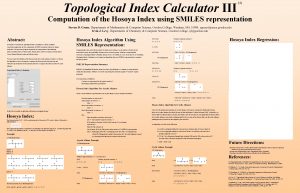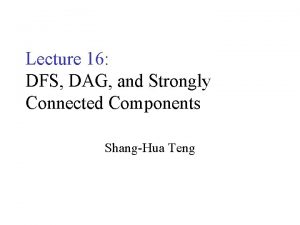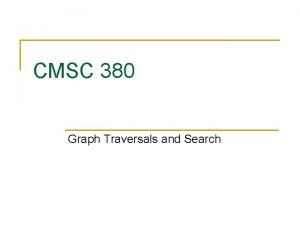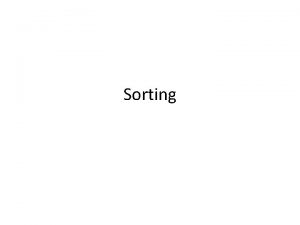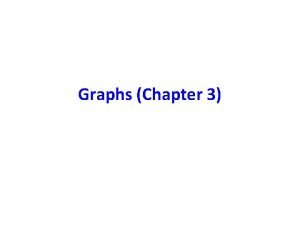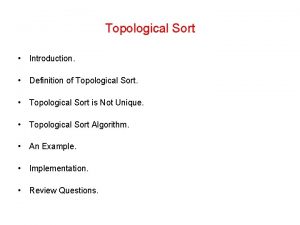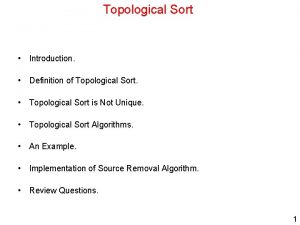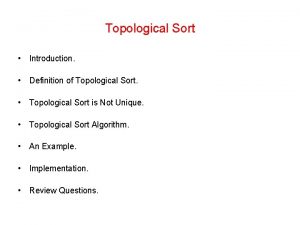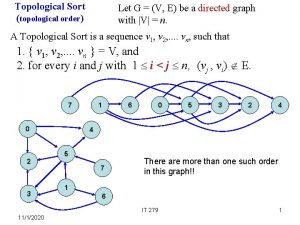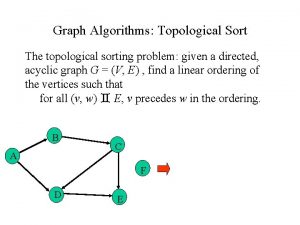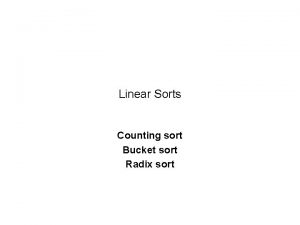Topological Sort Introduction Definition of Topological Sort Topological












- Slides: 12

Topological Sort • Introduction. • Definition of Topological Sort. • Topological Sort is Not Unique. • Topological Sort Algorithms. • An Example. • Implementation of Source Removal Algorithm. • Review Questions. 1

Introduction • There are many problems involving a set of tasks in which some of the tasks must be done before others. • For example, consider the problem of taking a course only after taking its prerequisites. • Is there any systematic way of linearly arranging the courses in the order that they should be taken? Yes! - Topological sort. 2

What is a DAG? • A directed acyclic graph (DAG) is a directed graph without cycles. Example: • DAGs arrise in modeling many problems that involve prerequisite constraints (construction projects, course prerequisites, document version control, compilers, etc. ) • Some properties of DAGs: – Every DAG must have at least one vertex with in-degree zero and at least one vertex with out-degree zero • A vertex with in-degree zero is called a source vertex, a vertex with outdegree zero is called a sink vertex. – G is a DAG iff each vertex in G is in its own strongly connected component – Every edge (v, w) in a DAG G has finishing. Time[w] < finishing. Time[v] in a DFS traversal of G 3

Definition of Topological Sort • Given a directed graph G = (V, E) a topological sort of G is an ordering of V such that for any edge (u, v), u comes before v in the ordering. • Example 1: • Example 2: 4

Definition of Topological Sort • Example 3: The graph in (a) can be topologically sorted as in (b) (a) (b) 5

Topological Sort is not unique • Topological sort is not unique. • The following are all topological sort of the graph below: s 1 = {a, b, c, d, e, f, g, h, i} s 2 = {a, c, b, f, e, d, h, g, i} s 3 = {a, b, d, c, e, g, f, h, i} s 4 = {a, c, f, b, e, h, d, g, i} etc. 6

Topological Sort Algorithms: DFS based algorithm Topological-Sort(G) { 1. Call dfs. All. Vertices on G to compute f[v] for each vertex v 2. If G contains a back edge (v, w) (i. e. , if f[w] > f[v]) , report error ; 3. else, as each vertex is finished prepend it to a list; // or push in stack 4. Return the list; // list is a valid topological sort } • Running time is O(V+E), which is the running time for DFS. Topological order: A C D B E H F G 7

Topological Sort Algorithms: Source Removal Algorithm • The Source Removal Topological sort algorithm is: – Pick a source u [vertex with in-degree zero], output it. – Remove u and all edges out of u. – Repeat until graph is empty. int topological. Order. Traversal( ){ int num. Visited. Vertices = 0; while(there are more vertices to be visited){ if(there is no vertex with in-degree 0) break; else{ select a vertex v that has in-degree 0; visit v; num. Visited. Vertices++; delete v and all its emanating edges; } } return num. Visited. Vertices; } 8

Topological Sort: Source Removal Example • The number beside each vertex is the in-degree of the vertex at the start of the algorithm. 1 2 3 0 2 A B C D E F G H I J 1 0 2 2 0 D G A B F H J E I C 9

Implementation of Topological Sort • The algorithm is implemented as a traversal method that visits the vertices in a topological sort order. • An array of length |V| is used to record the in-degrees of the vertices. Hence no need to remove vertices or edges. • A priority queue is used to keep track of vertices with in-degree zero that are not yet visited. public int topological. Order. Traversal(Visitor visitor){ int num. Vertices. Visited = 0; int[] in. Degree = new int[number. Of. Vertices]; for(int i = 0; i < number. Of. Vertices; i++) in. Degree[i] = 0; Iterator p = get. Edges(); while (p. has. Next()) { Edge edge = (Edge) p. next(); Vertex to = edge. get. To. Vertex(); in. Degree[get. Index(to)]++; } 10

Implementation of Topological Sort Binary. Heap queue = new Binary. Heap(number. Of. Vertices); p = get. Vertices(); while(p. has. Next()){ Vertex v = (Vertex)p. next(); if(in. Degree[get. Index(v)] == 0) queue. enqueue(v); } while(!queue. is. Empty() && !visitor. is. Done()){ Vertex v = (Vertex)queue. dequeue. Min(); visitor. visit(v); num. Vertices. Visited++; p = v. get. Successors(); while (p. has. Next()){ Vertex to = (Vertex) p. next(); if(--in. Degree[get. Index(to)] == 0) queue. enqueue(to); } } return num. Vertices. Visited; } 11

Review Questions 1. List the order in which the nodes of the directed graph GB are visited by 2. topological order traversal that starts from vertex a. Use both DFS-based and Source Removal algorithm 2. What kind of DAG has a unique topological sort? 3. Generate a directed graph using the required courses for your major. Now apply topological sort on the directed graph you obtained. 12
 Graph topological sort
Graph topological sort Topological sort pseudocode
Topological sort pseudocode Topological sort calculator
Topological sort calculator Topological sort calculator
Topological sort calculator Topological sort applications
Topological sort applications Topological sort online
Topological sort online Dfs connected components
Dfs connected components Topological sort pseudocode
Topological sort pseudocode Topological sort
Topological sort Topological sort bfs
Topological sort bfs Topological sort can be implemented by?
Topological sort can be implemented by? Topological sort can be implemented by?
Topological sort can be implemented by? Graph topological sort
Graph topological sort


